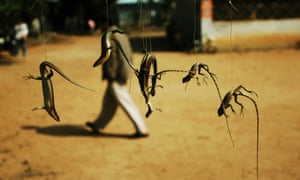Extract from The Guardian
Journals begin withholding locations after
warnings the data is helping smugglers drive lizards, snakes and
frogs to ‘near-extinction’
Goniurosaurus kwangsiensis, is a new
species of gecko discovered in China. Photograph: Yang Jian-Huang and
Bosco Chan Pui-lok/Kadoorie Conservation China
Arthur
Neslen in Brussels
Saturday 2 January 2016 00.34 AEDT
Academic journals have begun withholding the
geographical locations of newly discovered species after poachers
used the information in peer-reviewed papers to collect previously
unknown lizards, frogs and snakes from the wild, the Guardian has
learned.
In an age of extinctions, scientists usually love
to trumpet the discovery of new species, revealing biological and
geographical data that sheds new light on the mysteries of evolution.
But earlier this year, an announcement in the
Zootaxa academic
journal that two new species of large gecko had
been found in southern China contained a strange omission: the
species’ whereabouts.
“Due to the popularity of this genus as novelty
pets, and recurring cases of scientific descriptions driving
herpetofauna to near-extinction by commercial collectors, we do not
disclose the collecting localities of these restricted-range species
in this publication,” the paper said.
The relevant data was instead lodged with
government agencies, and would be available to fellow scientists on
request, the study made clear.
“The publishing of data identifying geographic
locations poses a threat to the survival of some newly discovered
species,” said Mark Auliya, a biologist at the Helmholtz Centre for
Environmental Research and co-chair International Union for the
Conservation
of Nature (IUCN)’s monitor lizard specialist group.
“Locality information is used and misused by
traders. Printing the location of animals that are rare, protected,
endangered, or endemic to specific islands or habitats can easily
create a market demand, especially if they are charismatic, colourful
or unique in their morphology.”
The International
Commission on Zoological Nomenclature does not oblige scientists
to provide GPS coordinates for newly discovered species, but many do
as an act of empirical completion.
Even when species locations are not precisely
mapped, black market traders can often track them down, using local
contacts and big cash offers that turn the heads of poor farmers.
Just four months after Zootaxa published discovery
information about a new leaf-tailed gecko in Madagascar last
summer, the animal began appearing in Europe.
Populations of the
critically endangered Roti Island snake-necked turtle were
“severely depleted” by wildlife smugglers, after a newly distinct
species was identified in Indonesia by a peer-reviewed paper in 1994,
Auliya said.
A Dendrobates galactonotus frog, a
species at risk of extinction. Experts are calling for a multimillion
pound rescue mission to save frogs and other amphibians from
extinction. Photograph: Ron D Holt/PA./PA
In 2013, Marinus Hoogmoed and his wife announced
the discovery of a new light blue morph of poison dart frog
(Dendrobates galactonotus) – and its location in Amazonian
Brazil – in the Phyllomedusa journal.
Three months later, a terrarium keeper in Germany
sent him photos of the new morph, which he said he had been offered
on the German trade circuit, at prices of between €350-700.
Hoogmoed, a retired herpetologist and former
curator of reptiles and amphibians at Leiden’s natural history
museum, complained to the authorities in Brazil, which prohibits the
export of all wildlife. But the case was not pursued.
“The problem is that inspection and law
enforcement in Brazil for wildlife is, at the least, weak,” he told
the Guardian. “As this trade is relatively small and does not
involve high-profile animals or large amounts of money, there is not
much interest to make a juridical case.”
Environmental crimes of this type were “not
considered a priority” in Brazil, he added.
Ariadne Angulo, the co-chair of the IUCN’s
amphibian specialist group said that the scientific community was
increasingly discussing withholding location data in internal forums
and dialogues.
“It’s an ethical conundrum,” she said. “Many
scientists are caught in the dilemma that: here we are with a species
no one knows - its not even considered a species - they describe it,
provide locality information, it makes it into the primary data and a
few months later that species is found on the market.”
The IUCN has guidelines
prohibiting the publication of location data for endangered species
of high economic value that are threatened by the pet trade, but many
journals do not yet.
Colour changing tree monitors or garden lizards (
Calotes versicolor) and Bronze skinks ( Lygosoma
indicum) hung in a street market to be sold as pets in Hainan
province, China. Photograph: Xiao Shibai/Alamy
The problem – which also affects snakes,
molluscs, butterflies and birds - is most acutely felt in the
amphibian and reptile fields. Only 8% of the world’s 10,200 reptile
species are regulated by the International Convention on Trade in
Endangered Species (Cites), leaving the rest to the vagaries of the
market.
The IUCN has assessed less than half of the
world’s reptiles, but estimates that at least 1,390 are threatened
by “biological resource use”. Around 350 of these have been
targeted by international collectors, mostly non-Cites listed
species.
Ten EU countries have reported the import of more
than 20 million live reptiles in the last decade, according to
Eurostat figures.



No comments:
Post a Comment